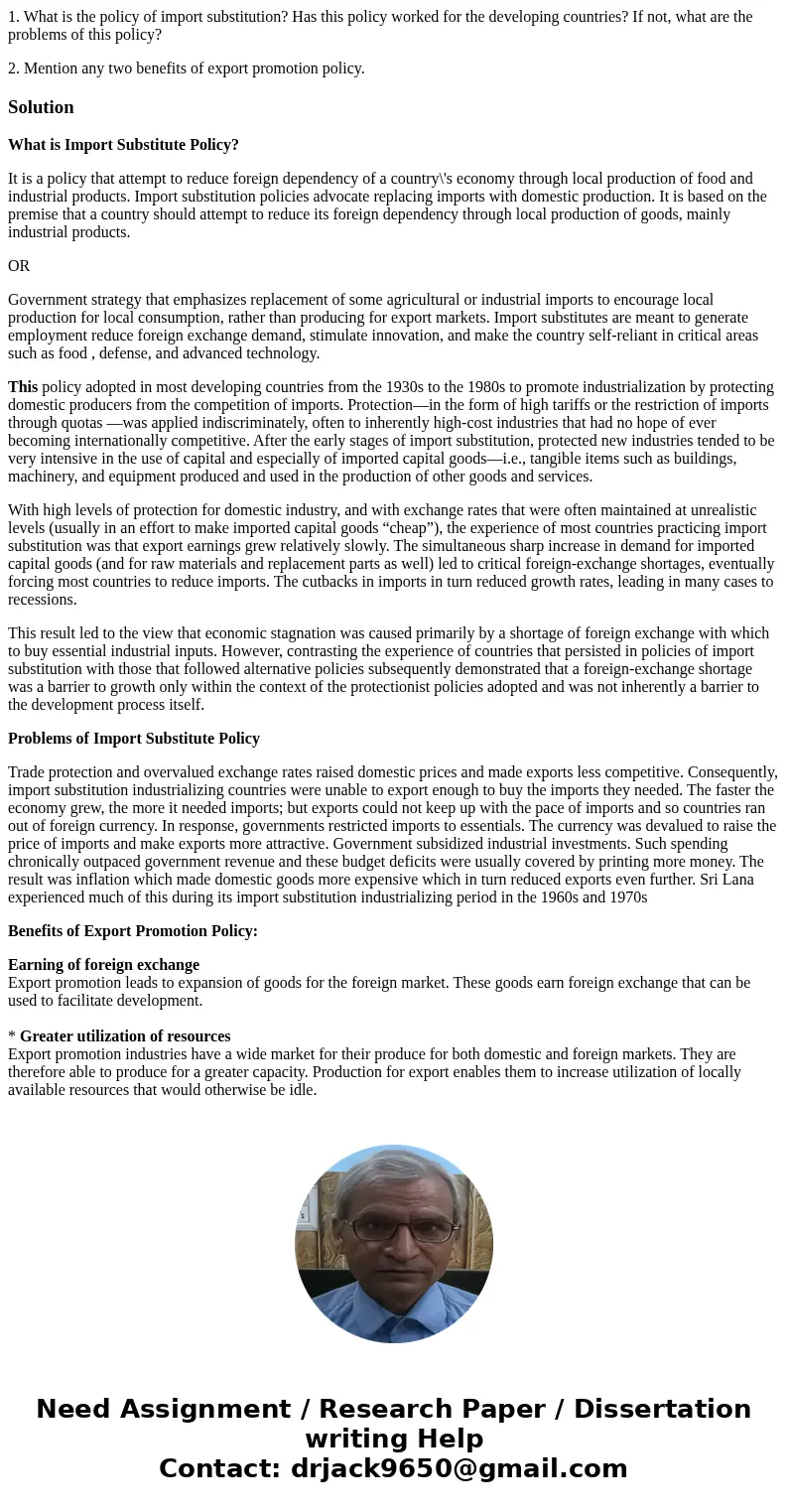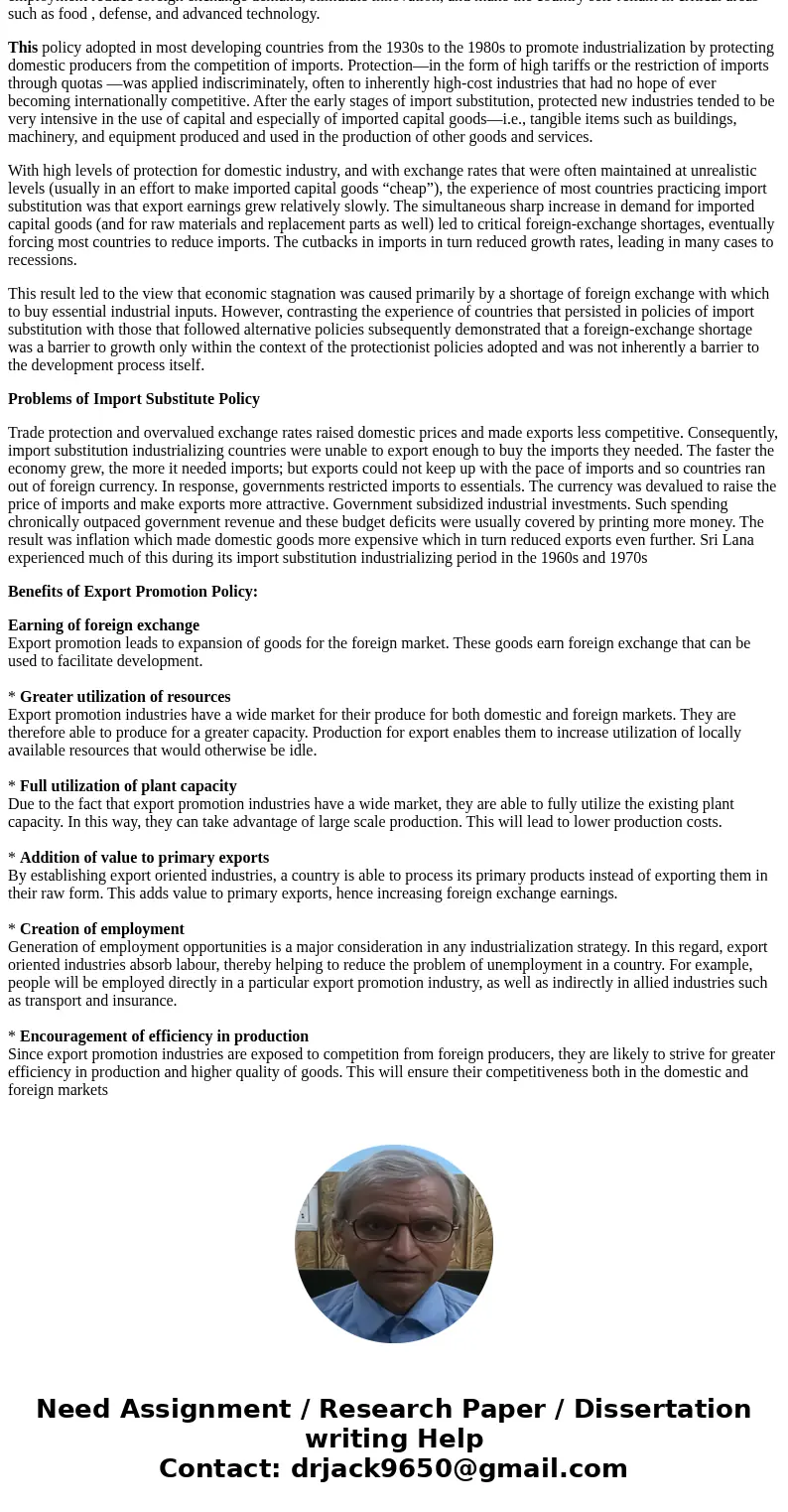1 What is the policy of import substitution Has this policy
1. What is the policy of import substitution? Has this policy worked for the developing countries? If not, what are the problems of this policy?
2. Mention any two benefits of export promotion policy.
Solution
What is Import Substitute Policy?
It is a policy that attempt to reduce foreign dependency of a country\'s economy through local production of food and industrial products. Import substitution policies advocate replacing imports with domestic production. It is based on the premise that a country should attempt to reduce its foreign dependency through local production of goods, mainly industrial products.
OR
Government strategy that emphasizes replacement of some agricultural or industrial imports to encourage local production for local consumption, rather than producing for export markets. Import substitutes are meant to generate employment reduce foreign exchange demand, stimulate innovation, and make the country self-reliant in critical areas such as food , defense, and advanced technology.
This policy adopted in most developing countries from the 1930s to the 1980s to promote industrialization by protecting domestic producers from the competition of imports. Protection—in the form of high tariffs or the restriction of imports through quotas —was applied indiscriminately, often to inherently high-cost industries that had no hope of ever becoming internationally competitive. After the early stages of import substitution, protected new industries tended to be very intensive in the use of capital and especially of imported capital goods—i.e., tangible items such as buildings, machinery, and equipment produced and used in the production of other goods and services.
With high levels of protection for domestic industry, and with exchange rates that were often maintained at unrealistic levels (usually in an effort to make imported capital goods “cheap”), the experience of most countries practicing import substitution was that export earnings grew relatively slowly. The simultaneous sharp increase in demand for imported capital goods (and for raw materials and replacement parts as well) led to critical foreign-exchange shortages, eventually forcing most countries to reduce imports. The cutbacks in imports in turn reduced growth rates, leading in many cases to recessions.
This result led to the view that economic stagnation was caused primarily by a shortage of foreign exchange with which to buy essential industrial inputs. However, contrasting the experience of countries that persisted in policies of import substitution with those that followed alternative policies subsequently demonstrated that a foreign-exchange shortage was a barrier to growth only within the context of the protectionist policies adopted and was not inherently a barrier to the development process itself.
Problems of Import Substitute Policy
Trade protection and overvalued exchange rates raised domestic prices and made exports less competitive. Consequently, import substitution industrializing countries were unable to export enough to buy the imports they needed. The faster the economy grew, the more it needed imports; but exports could not keep up with the pace of imports and so countries ran out of foreign currency. In response, governments restricted imports to essentials. The currency was devalued to raise the price of imports and make exports more attractive. Government subsidized industrial investments. Such spending chronically outpaced government revenue and these budget deficits were usually covered by printing more money. The result was inflation which made domestic goods more expensive which in turn reduced exports even further. Sri Lana experienced much of this during its import substitution industrializing period in the 1960s and 1970s
Benefits of Export Promotion Policy:
Earning of foreign exchange
Export promotion leads to expansion of goods for the foreign market. These goods earn foreign exchange that can be used to facilitate development.
* Greater utilization of resources
Export promotion industries have a wide market for their produce for both domestic and foreign markets. They are therefore able to produce for a greater capacity. Production for export enables them to increase utilization of locally available resources that would otherwise be idle.
* Full utilization of plant capacity
Due to the fact that export promotion industries have a wide market, they are able to fully utilize the existing plant capacity. In this way, they can take advantage of large scale production. This will lead to lower production costs.
* Addition of value to primary exports
By establishing export oriented industries, a country is able to process its primary products instead of exporting them in their raw form. This adds value to primary exports, hence increasing foreign exchange earnings.
* Creation of employment
Generation of employment opportunities is a major consideration in any industrialization strategy. In this regard, export oriented industries absorb labour, thereby helping to reduce the problem of unemployment in a country. For example, people will be employed directly in a particular export promotion industry, as well as indirectly in allied industries such as transport and insurance.
* Encouragement of efficiency in production
Since export promotion industries are exposed to competition from foreign producers, they are likely to strive for greater efficiency in production and higher quality of goods. This will ensure their competitiveness both in the domestic and foreign markets


 Homework Sourse
Homework Sourse